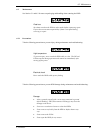
Diagnostics and Maintenance
66 C141-E252
Brief test contents of self-diagnostics are as follows.
a. Hardware function test
This test checks the basic operation of the controller section, and contains following test.
• RAM (microcode is stored)
• Peripheral circuits of microprocessor (MPU)
• Data buffer
b. Seek test
This test checks the positioning operation of the HDD using several seek modes (2 points seek, 1
position sequential seek, etc.). The positioning operation is regarded as success when the seek
operation to the target cylinder is completed.
c. Write/read test
This test checks the write/read function by using the internal test space of the HDD.
(1) Initial self-diagnostics
When the HDDs are turned on, they run the initial self-diagnostics. The initial self-diagnostics test
the basic operations of hardware functions.
If the initial self-diagnostics detect an error, the LED on the HDD blinks (at 0.4-second intervals).
The HDDs in this state post the CHECK CONDITION status to all I/O operation requests except the
REQUEST SENSE command. The initiator can collect sense data when the CHECK CONDITION
status is posted.
Sense data contains detailed information on the error detected by the initial self-diagnostics.
When sense data has been collected after the CHECK CONDITION status has been posted, the
CHECK CONDITION status continues and the LED keeps blinking. This status can be cleared only
when the HDDs are turned off and turned on again. When the status is cleared, the HDDs run the
initial self-diagnostics again.
The HDDs do not reply to requests from the host system for a maximum of 2 seconds after the start
of the initial self-diagnostics. Thereafter, the HDDs can accept I/O operation requests normally, but
any received command, except commands that are executable even in the not ready state, is
terminated with the CHECK CONDITION status until the spindle motor reaches the normal
rotational speed and the HDDs become ready. The commands that are executable even in the not
ready state are executed in parallel with the initial self-diagnostics, or they are queued by the
command queuing feature and executed when the initial self-diagnostics is completed.
If the initial self-diagnostics detect an error, the CHECK CONDITION status is posted for all of the
commands received and queued during the initial self-diagnostics.


















